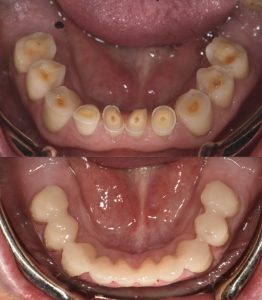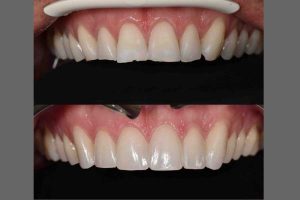
Tooth Repairs
Having a cracked, chipped and missing tooth is very common, and happens for many different reasons. There might not be any pain just yet, but it’s extremely important to get it looked at. Often, these cracks and chips continue to deteriorate leading to extreme pain when they reach the root of your tooth. You don’t want to un-necessarily suffer for a very treatable tooth issue We are experts in repairing broken or chipped teeth. Using the latest dental technology we can help you achieve a beautiful, natural smile.
Breaking a tooth can be a distressing experience when your first thought often is – “will it need to be pulled out?”. In our experiences, unless the result of severe decay or trauma, most teeth can be repaired to an extent, preventing the dreaded extraction.
Can my tooth be saved?
The difficulty and extensiveness of repairing a tooth is directly related to the size and type of breakage, any associated symptoms such as pain or sensitivity, and how long it has been since the breakage occurred. Understandably, we encourage our patients to visit us as soon as possible after breaking a tooth as time can be of the essence. As dentists, we always endeavour to save our patients teeth rather than extract them.
How will my tooth be repaired?
The goal of tooth repairs is to essentially replace the breakage that has occurred, whether it be an old filling or the tooth itself that has broken. At the simplest, we would repair your small breakage with standard white filling material. In more difficult cases where large breakages occur, we would need to use stronger materials to prevent future breakages such as porcelain. If there has been pain or sensitivity associated with the broken tooth, on occasion a root canal is necessary to alleviate this pain and potential infection prior to building up the tooth with a porcelain crown.
What is the process of getting my tooth repaired?
Your initial appointment will be an emergency consultation where the dentist will assess the severity of the breakage through an examination and dental x-ray. Should the breakage be minor, we will endeavour to repair it the same day. In the event of more complex breakages, we will book you a subsequent appointment to be able to perform the highest quality of dental treatment.
What you need to know about White fillings
White dental fillings are generally made from composite resin. Because of their colour, they blend in more naturally with the rest of your teeth. These days, almost all fillings are made from composite resin because they look better than their silver counterparts and they are less invasive.
There are other types of white fillings which are made from porcelain. We call these inlays or onlays and these are used to strengthen the tooth. They are made outside of the mouth and then bonded to the tooth. This is different to the composite resin fillings which are made directly in the mouth.

The History of Dental Fillings
Dental fillings have been around longer than you may realise. They date back around 6000 years. The earliest dental fillings ever found were in the body of a man found in Trieste, Italy. His fillings were made from beeswax. The earliest use of amalgam was found in a Chinese medical text from 700AD.
Major breakthroughs in dentistry occurred in 1530 with the publication of Artzney Buchlein’s book The Little Medicinal Book for All Kinds of Diseases and Infirmities of the Teeth. This German text contained all kinds of useful information including how to make gold fillings.
It wasn’t until 1746 that dentistry saw the first attempts at making crowns that matched existing teeth. A procedure was developed that used white enamel to make gold crowns blend in with the surrounding natural teeth.
Nicolas Dubois made a breakthrough in dentistry in 1789 when he introduced porcelain. He was the first person to get a patent for porcelain teeth. Commercial manufacturing of porcelain teeth did not begin until 1825. Samuel Stockton was the world’s largest manufacturer of orthodontic supplies.
The late 1800s saw the use of amalgam fillings as a more economical alternative to gold. Although initially, the technique did not catch on, amalgam fillings eventually become popular. The fillings became controversial after warnings from the American Society of Dental Surgeons about the amount of mercury in amalgam. However, they continued to be used and were the most popular form of filling during the 19th and 20th centuries.
Fast forward to the 21st century. Today, dentists have a wider range of techniques and materials than ever before. Composite resin is the most common form of filling material. It is the most versatile material for this time of restoration and it is also mercury-free.

The Benefits of Composite Fillings
There are numerous benefits from having composite filing, including:
- Safety: Around 50% of amalgam filling consists of mercury. Composite resin fillings are made from acrylic resin that is reinforced with ceramic particles such as silica or powdered glass quartz. As well as not being a health risk, resin fillings are more durable than amalgam because they do not expand and contract due to changes in temperature the way that metal fillings do. This means they put less stress on your teeth.
- Natural appearance: Composite fillings are designed to match the colour of your natural teeth. So, there are no more flashes of metal when you laugh or smile.
- Strength: Unlike amalgam fillings, composite fillings are bonded directly onto the tooth. Once the resin fills a cavity, the tooth is much stronger than it was before. Because amalgam fillings do not bond to the tooth, they cannot support the tooth when it flexes on eating.
Why Replace Your Silver Fillings?
It’s easy to see why metal fillings have lost their popularity. But thousands of people throughout the world still have them. If you are one of them, should you have them replaced with composite fillings?
The process isn’t always necessary, particularly if your teeth are healthy and your fillings are still in good shape. But if your metal fillings are loose or damaged and your cavities are exposed, replacing them with white fillings is definitely a good idea.
You may want to replace your silver fillings even if they are not damaged. You may prefer not to have any visible metal in your teeth. If so, replacing your fillings can make your teeth look natural and uniform. Talk to your dentist about your options.

Frequently Asked Questions About Composite Fillings
What is composite resin?
Composite resin was first introduced to dentistry during the 1960s. It is a tooth-colored resinous material made from Bis-GMA and other dimethacrylate monomers. Over the years composite resins have been strengthened so that they can now withstand the pressure of the molars. This means they can now be used to fill the front and back teeth. Resin is not only used to restore cavities. It can also be used to improve the shape and color of the teeth.
How long does it take to place a composite filling?
Resin filling can take up to an hour to place. This depends on the location and the size of the cavity. Composite filling typically takes about 20 minutes longer than an amalgam filling. This is because the tooth must be kept dry while the layers of resin are added. Once the composite is complete, your dentist will use a special light to cure it. It takes less than a minute to harden.
Can a composite resin filling be repaired?
Sometimes excessive chewing and grinding can cause the resin in your fillings to degrade. If this happens, your dentist will notice straight away. They can then clean and repair the filling.
How long does a composite filling last?
A composite filling can last between 5 and 10 years.

What factors affect the life of a white filling?
Several different factors including:
- The location of the filling
- The size of the filling
- Grinding or clenching your teeth
- What you eat and drink
- Your oral hygiene practices
How do I care for my composite fillings?
You should maintain your usual oral hygiene habits. That means brushing at least twice each day and flossing before you go to bed. You should also make regular six-month visits to your dentist for a check-up and a professional cleaning.
Composite fillings are a safe and durable way to fix cavities in your teeth. If you have amalgam fillings and you would like to have them replaced, talk to your dentist about your options.
We’re dedicated to providing you with the highest quality dental care. If you would like to know more about white fillings schedule a consultation today.
